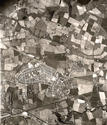 In the 1950s the remaining industries in the immediate Baillieston area began to disappear with the closure in 1956 of the Rhinsdale Preserve Works, the "Jeely Works" in the very heart of Baillieston. At the same time, to tackle acute post-war housing shortage, house building in the private and public sectors continued to expand.
In the 1950s the remaining industries in the immediate Baillieston area began to disappear with the closure in 1956 of the Rhinsdale Preserve Works, the "Jeely Works" in the very heart of Baillieston. At the same time, to tackle acute post-war housing shortage, house building in the private and public sectors continued to expand.
 The 1970s were a decade of change. In 1973 Baillieston railway station closed to all traffic, Bannerman High School opened on the site of the recently demolished Baillieston House, a new Parish Church of St Andrew was built as a successor to the 1833 Crosshill Kirk, and a new sports and social centre followed in 1974.
The 1970s were a decade of change. In 1973 Baillieston railway station closed to all traffic, Bannerman High School opened on the site of the recently demolished Baillieston House, a new Parish Church of St Andrew was built as a successor to the 1833 Crosshill Kirk, and a new sports and social centre followed in 1974.
 Two major changes followed: the annexation of Baillieston to Glasgow in 1975 and the construction of the M8/M73 through Baillieston (1977-1980) to the north of Swinton resulting in the loss of much farmland. Both may have contributed to the upsurge of interest in local history after the exhibition "Baillieston, a Community remembered" was mounted in Baillieston Library in 1979. This provoked a spate of books and articles which chronicled the history of the villages whose people merged to form the present community: Crosshill, Muirside and the Baulks, Swinton, Garrowhill and Barrachnie. Baillieston Gala Day was reinstated and Baillieston Juniors football team won the Scottish Junior Cup in 1980.
Two major changes followed: the annexation of Baillieston to Glasgow in 1975 and the construction of the M8/M73 through Baillieston (1977-1980) to the north of Swinton resulting in the loss of much farmland. Both may have contributed to the upsurge of interest in local history after the exhibition "Baillieston, a Community remembered" was mounted in Baillieston Library in 1979. This provoked a spate of books and articles which chronicled the history of the villages whose people merged to form the present community: Crosshill, Muirside and the Baulks, Swinton, Garrowhill and Barrachnie. Baillieston Gala Day was reinstated and Baillieston Juniors football team won the Scottish Junior Cup in 1980.
By the time the development of Springhill Farm for mixed housing was finally approved in 1983, the famous Springcroft Nurseries on part of the farmland had become the site of a Trading Centre. Baillieston continues to expand as a thriving, modern dormitory for people who work elsewhere.